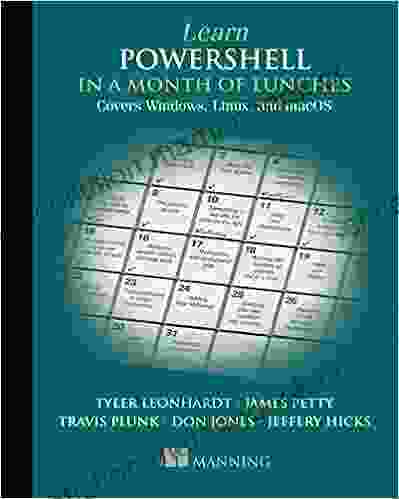Cross-Platform Code Coverage: Windows, Linux, and macOS

Code coverage is an essential metric for measuring the quality of software testing. It provides insights into the completeness and effectiveness of your testing efforts, ensuring that all aspects of your code are thoroughly tested. However, achieving accurate code coverage across different platforms can be a challenge, especially when working with diverse operating systems like Windows, Linux, and macOS.
4.6 out of 5
| Language | : | English |
| File size | : | 7906 KB |
| Text-to-Speech | : | Enabled |
| Screen Reader | : | Supported |
| Enhanced typesetting | : | Enabled |
| Print length | : | 359 pages |
Challenges of Cross-Platform Code Coverage
- Platform-Specific Dependencies: Different platforms utilize unique libraries, frameworks, and APIs, which can impact code coverage measurement techniques.
- Compilation Differences: Code compilation can vary across platforms, leading to different code paths being executed and affecting coverage results.
- Tool Availability: Code coverage tools may not be available or compatible with all platforms, limiting your ability to collect comprehensive coverage data.
Solutions for Cross-Platform Code Coverage
1. Use Platform-Agnostic Coverage Tools
Opt for code coverage tools that are platform-independent, such as JaCoCo for Java or Istanbul for JavaScript. These tools provide consistent coverage measurement across different platforms.
2. Employ Cross-Platform Testing Frameworks
Utilize testing frameworks like Selenium or Cypress, which support cross-platform testing and can provide coverage data for various operating systems.
3. Leverage Emulators and Virtual Machines
Run your code on emulators or virtual machines that simulate different platforms. This allows you to test your code on target operating systems without the need for physical devices.
Specific Considerations for Each Platform
Windows
- Consider using Visual Studio's built-in code coverage features or third-party tools like Coverlet or dotCover.
- Address platform-specific dependencies, such as .NET assemblies and Windows APIs, by including appropriate test cases.
Linux
- Utilize open-source code coverage tools like Gcov or JaCoCo, which are widely used in Linux environments.
- Handle platform-specific dependencies, such as GNU C Library functions and kernel interfaces, through targeted testing.
macOS
- Leverage Apple's Xcode IDE, which includes built-in code coverage capabilities.
- Address platform-specific dependencies, such as Cocoa frameworks and Objective-C runtime, by incorporating appropriate test cases.
Tips for Achieving Comprehensive Coverage
- Define Clear Coverage Goals: Determine the desired level of coverage for each platform based on project requirements.
- Create Diverse Test Scenarios: Develop test cases that cover a wide range of code paths and scenarios.
- Use Static and Runtime Coverage: Combine static (e.g., code analysis) and runtime (e.g., execution-based) coverage techniques for comprehensive insights.
- Review and Analyze Coverage Data: Regularly review coverage reports and identify areas with low or no coverage for further testing.
Benefits of Cross-Platform Code Coverage
- Improved Software Quality: Ensures comprehensive testing and reduces the risk of undiscovered defects.
- Enhanced Cross-Platform Compatibility: Verifies that code behaves consistently across different platforms.
- Increased Test Efficiency: Identifies areas where testing efforts can be optimized.
- Better Debugging and Maintenance: Provides valuable information for troubleshooting and code maintenance.
Measuring code coverage across different platforms is crucial for delivering high-quality software. By embracing platform-agnostic tools, cross-platform testing frameworks, and platform-specific considerations, you can achieve comprehensive coverage and ensure the reliability of your code across Windows, Linux, and macOS.
4.6 out of 5
| Language | : | English |
| File size | : | 7906 KB |
| Text-to-Speech | : | Enabled |
| Screen Reader | : | Supported |
| Enhanced typesetting | : | Enabled |
| Print length | : | 359 pages |
Do you want to contribute by writing guest posts on this blog?
Please contact us and send us a resume of previous articles that you have written.
 Top Book
Top Book Novel
Novel Fiction
Fiction Nonfiction
Nonfiction Literature
Literature Paperback
Paperback Hardcover
Hardcover E-book
E-book Audiobook
Audiobook Bestseller
Bestseller Classic
Classic Mystery
Mystery Thriller
Thriller Romance
Romance Fantasy
Fantasy Science Fiction
Science Fiction Biography
Biography Memoir
Memoir Autobiography
Autobiography Poetry
Poetry Drama
Drama Historical Fiction
Historical Fiction Self-help
Self-help Young Adult
Young Adult Childrens Books
Childrens Books Graphic Novel
Graphic Novel Anthology
Anthology Series
Series Encyclopedia
Encyclopedia Reference
Reference Guidebook
Guidebook Textbook
Textbook Workbook
Workbook Journal
Journal Diary
Diary Manuscript
Manuscript Folio
Folio Pulp Fiction
Pulp Fiction Short Stories
Short Stories Fairy Tales
Fairy Tales Fables
Fables Mythology
Mythology Philosophy
Philosophy Religion
Religion Spirituality
Spirituality Essays
Essays Critique
Critique Commentary
Commentary Glossary
Glossary Bibliography
Bibliography Index
Index Table of Contents
Table of Contents Preface
Preface Introduction
Introduction Foreword
Foreword Afterword
Afterword Appendices
Appendices Annotations
Annotations Footnotes
Footnotes Epilogue
Epilogue Prologue
Prologue Diana Palmer
Diana Palmer Ivy Barrett
Ivy Barrett Bradley Harper
Bradley Harper Christopher Herrera
Christopher Herrera Elizabeth Hickey
Elizabeth Hickey Tara Brown
Tara Brown Jonathan Hirshon
Jonathan Hirshon Brendan Walsh
Brendan Walsh Donald Crane
Donald Crane Angelos Mavros
Angelos Mavros Francisca Orellana Polanka
Francisca Orellana Polanka Julia Pascal
Julia Pascal Marly Bird
Marly Bird Donald A Schon
Donald A Schon Shifio S Patterns
Shifio S Patterns Keith E Sparks Jr
Keith E Sparks Jr Michael Edwards
Michael Edwards Michio Kaku
Michio Kaku Brittany Reeder
Brittany Reeder Tony Prodger
Tony Prodger
Light bulbAdvertise smarter! Our strategic ad space ensures maximum exposure. Reserve your spot today!

 Albert ReedAn In-Depth Exploration of "The Cherry Orchard" and Other Acclaimed Plays by...
Albert ReedAn In-Depth Exploration of "The Cherry Orchard" and Other Acclaimed Plays by... Hassan CoxFollow ·19.8k
Hassan CoxFollow ·19.8k Osamu DazaiFollow ·15.3k
Osamu DazaiFollow ·15.3k Carl WalkerFollow ·4k
Carl WalkerFollow ·4k Devin RossFollow ·13k
Devin RossFollow ·13k Fernando PessoaFollow ·10.4k
Fernando PessoaFollow ·10.4k W.B. YeatsFollow ·17.6k
W.B. YeatsFollow ·17.6k William ShakespeareFollow ·13.9k
William ShakespeareFollow ·13.9k Elias MitchellFollow ·5.9k
Elias MitchellFollow ·5.9k

 Ashton Reed
Ashton ReedClean(ish) Food for People Who Like to Eat Dirty
By: [Your Name] Are...

 Ronald Simmons
Ronald SimmonsThe Handbook for Educators: A Comprehensive Guide to...
The Handbook for...

 Derrick Hughes
Derrick HughesAny Place Hang My Hat: A Hauntingly Beautiful Novel by...
A Masterpiece of...

 Adrien Blair
Adrien BlairFly Me to the Moon Vol. 5: A Lunar Odyssey through...
In the vast...

 William Powell
William PowellTips By Gardeners On Variety Of Subjects
Gardening...
4.6 out of 5
| Language | : | English |
| File size | : | 7906 KB |
| Text-to-Speech | : | Enabled |
| Screen Reader | : | Supported |
| Enhanced typesetting | : | Enabled |
| Print length | : | 359 pages |












